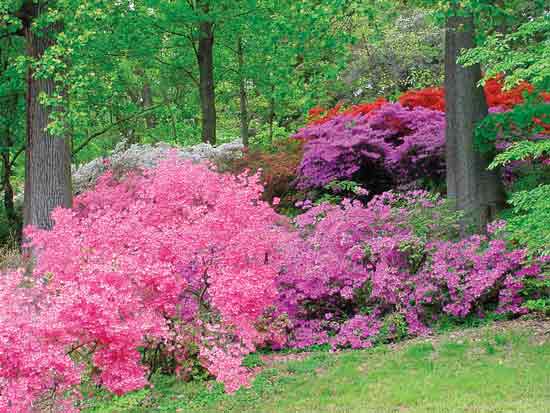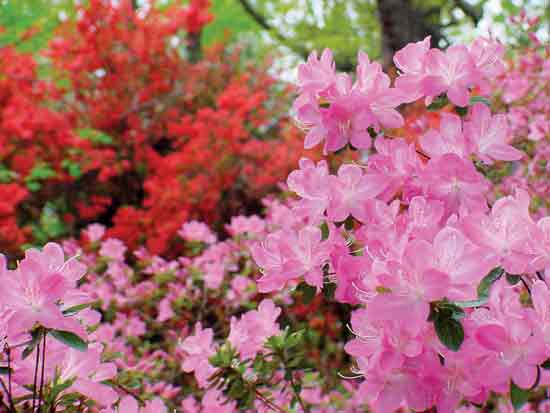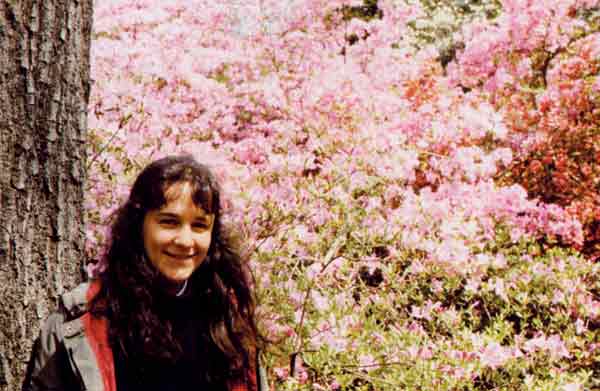JARS v63n1 - The Glenn Dale Azaleas: A History as Told by The Azalean, Part III
The Glenn Dale Azaleas: A History as Told by The Azalean, Part III
William C. Miller III
Bethesda, Maryland
Introduction
This is the third in a series of Glenn Dale articles originally published in
The Azalean
, the journal of the Azalea
Society of America (Vol. 14, No. 2, June 1992, pp.42-43). The third article was a logical extension of the previous article
which outlined the development of the Glenn Dale hybrids and put into perspective the large collection of azaleas that
came to be planted on the southern face of Mt. Hamilton at the US National Arboretum (the Arboretum). There were no
images with the original article, and three images have been added for this republication.
As the title of the article suggests, one goal was to demonstrate the existence of a constituency that was very interested in the Arboretum's azalea collection. Historically, the Arboretum has struggled to provide the necessary resources to fully maintain the collection; and over the years that problem had begun to show. Happily, Barbara Bullock, the current curator, has worked wonders with the collection and has gradually brought it back from the brink. Dick and I were motivated to write the article after a meeting that we had with select members of the Arboretum staff where one individual suggested that a solution to the azalea maintenance problem was to "bulldoze" the collection. He was quite correct in what he said, but we were not amused, and he's no longer with the Arboretum. A second major goal was to provide, for the record, an independent, non federal review of the condition and management of the azalea collection. It was crafted as the sort of product (a review with recommendations) that might have been developed by the National Arboretum Advisory Council which is mentioned in the article. Comprised of respected individuals with broad scientific, agricultural, and horticultural interests (e.g., Liberty Hyde Bailey, Frederick Law Olmsted, Frederic P. Lee, H. H. Hume, Fred Galle, Sandra McDonald, John Rochester, and Andre Viette), the council annually held two-day meetings in the spring and fall. Authorized by Section 4 of Public Law 799 enacted on March 4, 1927, the purpose of the Arboretum's Council was to review and make recommendations in the areas of physical development, programs of research and education, budgetary needs, and staff needs. While the National Arboretum Advisory Council was discontinued in the early 1990s, the Arboretum periodically sponsors "Stakeholder's Meetings" which serve a similar purpose.
I will close this introduction on a positive note. In the ongoing matter of federal budgetary issues and limited resources, Barbara Bullock is still on the job and the azalea collection, as a whole, is better for it.
Bill Miller has published two books and many articles, has introduced four azalea cultivars ('Seattle White', 'Landon Pride', 'Brookside Delight', and 'Bobbi Gail'), and is a life member of both the ASA and the ARS.
The Massed Glenn Dale Azaleas on Mt. Hamilton at the National Arboretum: A Commentary and a Call for Action
William C. Miller III, Bethesda, Maryland and Richard T. West, Columbia, Maryland
Reprinted from The Azalean , Vol.14, No. 2, June 1992, with permission by the Azalea Society of America.
The results of an investigation of the massed Glenn Dale hybrid azaleas planted on the southern slope of Mt. Hamilton at the U.S. National Arboretum (NA) were reported in the March 1992 issue of The Azalean (1). The investigation found the massed planting to be an important and valuable germplasm collection, contrary to popular belief, comprising some of the very best azaleas selected from some 70,000 seedlings produced in the Glenn Dale hybridizing program of B.Y. Morrison. Donated to the NA for its permanent collection by Morrison's Division in the Bureau of Plant Industry, the more than 15,000 azaleas are arranged mostly in groups of twelve, representing about 1,200 individual selections.

|

|
|
|
View from near Azalea Road of one section of the massed
planting on the southern
face of Mt. Hamilton showing eight- to ten-foot high azaleas. Looking up the hill in a generally north-north-west direction, it is a mass of color as far as the eye can see. Photo by William C. Miller III |
Barbara Bullock reports that many of the original tags have
separated from
the azaleas and been lost. There was talk of a plat which described the layout, but no such document has been found. The azalea in foreground appears to be �Dayspring�. Photo by William C. Miller III |
The development of the massed planting was no accident. It was totally consistent with the reasons for which a national arboretum was established. Under Public Law 799, passed by the 69th Congress on March 4, 1927, the Secretary of Agriculture was authorized and directed to establish a national arboretum "for purposes of research and education concerning tree and plant life." In support of that legislative mandate and from the beginning, the NA intended to establish permanent living collections of plant material for the purpose of scientific research and education - or, in the words of Dr. Frederick V. Coville, first acting director and the father of the National Arboretum, to create a "bureau of standards for horticulture" (2). The NA has served and continues to serve professional botanists and horticultural researchers by maintaining such collections, which constitute valuable sources of germplasm.
The report of the investigation, coauthored with Barbara L. Bullock, Curator of Azaleas and Rhododendron at the NA, supports our hypothesis that the massed planting contains virtually all of the named and unnamed azaleas selected in the Glenn Dale program, including the unique group of hybrids that produced the color-bordered and white-edged flowers (e.g., 'Martha Hitchcock' and 'Surprise', respectively). Morrison candidly referred to the massed planting as the "cream of the hybrids that were produced" (3). The report states that the massed azaleas have historic and research value, but it does not state whether conditions and accessibility make research activities possible or elaborate on that research value with specific examples.

|
|
Barbara Bullock, Curator of Azaleas and Rhododendron at
the U.S. National Arboretum
in Washington DC. The photo was taken at the historic Ten Oaks Nursery in Clarksville, Maryland in April 1991. Photo by Dick West |
We are very concerned about the general condition of the massed azalea planting. While the azaleas on the hillside are a testament to the durability of azaleas in general and to the quality of the Glenn Dale hybrids in particular, nevertheless, the hillside azaleas are in a threatened state due to many years of neglect. The lack of basic maintenance has taken its toll. The mistaken belief that the contents of the hillside were rejects and castoffs has understandably contributed to their present condition. In places, the azaleas have been invaded by vines and all manner of weeds, and existing or volunteer trees need pruning or removal. Access to some parts of the planting is not now possible. Erosion and drainage problems persist, and over the years we have watched as sections of the planting have declined and died. Unless steps are taken to improve the situation, the rate of decline and loss will increase.
The picture is not entirely negative. The Friends of the National Arboretum (FONA) has come to recognize the problem and has committed funds (non-federal) for the creation of a four-month fellowship to aid the curator in the execution of her responsibilities. This is an important and symbolic first step to address problems with the azaleas, but much more needs to be done. As recently as last year, the National Arboretum's Advisory Council recommended that additional "support positions be provided, particularly new curators for the conifer, azalea/rhododendron, Fern Valley and holly/magnolia collections..." (4). The take-home message here is that the Arboretum's Advisory Council, like FONA, has recognized the problem and has formally reported that the Council gives "high priority" to the recommendation that full-time permanent staff be added to the azalea/rhododendron collection for the immediate care of the gardens.
We urge the NA to move quickly in response to the FONA action and the Advisory Council's recommendations. A comprehensive status report on the entire azalea collection is needed as a beginning. From it, a plan of action for improving the hillside, specifically, and the complete azalea collection in general should be developed. Priorities of action should be indicated, and the key problem of assuring the viability and continued maintenance of the azaleas should be clearly addressed. How the NA is to meet stewardship responsibilities for existing collections with available resources should be answered before any new and grandiose demonstration garden projects or initiatives are undertaken.
In order to assist the NA in developing an action plan, we recommend that an advisory group of outside experts be established to help address the need for an immediate remedial intervention, as well as to identify the resource level (as measured in committed staff) necessary for on-going maintenance. Membership should include azalea experts and horticulturists knowledgeable about azalea collections and landscaping, as well as representatives from FONA and the NA Advisory Council.
Once maintenance and access are assured, the massed hillside azaleas can provide a research resource from which many important developmental and research endeavors are possible. For reasons that have never been explained, there is no longer an active research program in azaleas at the Arboretum, despite the fact that there are numerous research opportunities of both a basic and applied nature that cry out for attention. The development of a yellow evergreen azalea has never been realized, although this probably is achievable using modern technology (vectors and recombinant DNA) that was not available to Ben Morrison or Robert Pryor. Petal blight, root rot, powdery mildew, and other conditions of fungal origin are major problems in the azalea and rhododendron trade for which the development of resistant cultivars would be a major advance and contribution to the horticultural community and industry.
The NA should be a repository of complete azalea collections, and starting with the Glenn Dales would be fitting (5). We would welcome the creation of a complete, accurate collection of the 454 named Glenn Dale hybrids. A priority task should be the identification of as many of the hillside azaleas as possible. Once identification is well underway, other studies would become feasible, and the NA should assist and encourage azalea researchers. An update of the descriptions of the Glenn Dales (Monograph 20) based on mature plants is needed and would be of tremendous benefit. Of equal value would be the creation of computer databases and photograph files for the Glenn Dale and other azaleas. The hillside azaleas can be an important germplasm resource for hybridizing to create improved varieties. Other examples of research include a study of "sporting" and the identification of the origins of certain Glenn Dale cultivars, such as 'Grace Freeman' and the assumed Glenn Dale, 'Ben Morrison'.
The Curator of Azalea and Rhododendrons at the NA, our colleague Barbara Bullock, has overseen many improvements to the hillside planting in a short period of time. The progress, when compared to the total task at hand, must be considered as prologue. She will barely be able to maintain the improvements made so far with her present resources, let alone work on more of the hillside. The azaleas have been an outstanding and prominent feature of the Arboretum since the beginning of its collection development. Their place of value and importance to the NA and to horticulture needs re-appreciation, and their maintenance must be assured.
References and Comments
1. West, R.T., Miller III, W.C., and Bullock, B.L. The massed Glenn Dale azaleas on Mt. Hamilton: A valuable collection
at the National Arboretum.
The Azalean
, March 1992, Vol. 14, No. 2, pages 8-13.
2.
Science
, December 25, 1925, Vol. LXII, No. 1617, pages 579-581.
3. A quote from a Morrison letter dated May 13, 1947, that was written to Robert Pyle who asked about the origin of the
hillside azaleas. Robert Pyle was President, Conard-Pyle Nursery Co., West Grove, PA; Chairman, Botanical Gardens and
Arboreta Committee of the American Association of Nurserymen, Inc.; and a member of the Arboretum's Advisory Council.
4. Report to the Honorable Clayton Yeutter, Secretary of Agriculture from the National Arboretum Advisory Council.
January 18, 1991.
5. The idea of having a complete Glenn Dale azalea hybrid collection at the NA was Morrison's goal originally, but it was
never achieved. Dr. Roy Magruder, Ron Bare, and others over the years have tried to complete the Arboretum's Glenn Dale
azalea collection without success.
Bill Miller is vice president of the Azalea Society of America, co-chairman of the Membership Committee, chairman of the Public Information Committee, and a chairman of the Glenn Dale Preservation Project. He is a member of the Brookside Gardens Chapter and has served as Chairman of Horticulture for the chapter's annual flower show for many years. He is as interested in the historical aspects of the azaleas as he is in the horticultural aspects. He is a frequent contributor to The Azalean.
Dick West, a native of Washington, DC, is a long-time member of the Azalea Society and is interested in the Glenn Dale hybrid azaleas. He is an occasional contributor to The Azalean.
